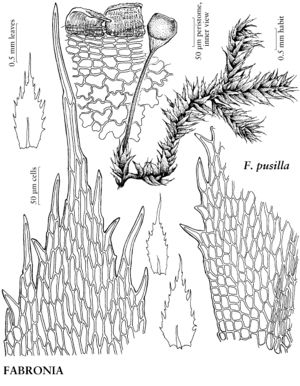Plants very small, often in silky mats, green, yellow-green, or gray-green. Stems often erect-ascending, sparsely and irregularly branched, branches terete-foliate, often subjulaceous; radiculose in scattered tufts. Leaves ovate to oblong-lanceolate, rarely lanceolate, often somewhat concave; margins plane, denticulate, dentate, or ciliate-dentate, rarely entire; apex acute, acuminate, or long-acuminate, subulate to piliferous, rarely blunt; costa single, 1/3–2/3 leaf length, terminal spine sometimes present, small; alar cells quadrate in several rows; basal laminal cells rounded-rhomboidal to rhomboidal, quadrate to transversely rectangular in few rows along margins; medial and distal cells rhombic, rhomboidal, or elongate-rhombic, 30–45 × 9–12 µm, smooth; apical cells linear. Specialized asexual reproduction apparently by foliose pseudoparaphyllia. Sexual condition autoicous. Seta single, light yellow, erect, smooth. Capsule with neck short, wrinkled when old, mouth often flared with age; exothecial cells +\- isodiametric, walls sinuate, suboral cells transversely elongate, angular, walls straight; stomata present in neck; annulus absent; operculum conic, umbonate to mammillate; peristome single, rarely absent, erect-spreading, sometimes recurved when dry, incurved when moist; exostome teeth 16, usually connate in pairs, red-brown, broadly lanceolate, blunt, 0.3 mm, densely papillose-striolate. Calyptra cucullate. Spores 9–14 µm, coarsely papillose or smooth.
Distribution
North America, Mexico, West Indies, Central America, South America, Eurasia, Africa, Atlantic Islands, Pacific Islands (Hawaii, New Zealand), Australia.
Discussion
Genera 5, species ca. 17 (1 genus, 2 species in the flora).
Selected References
None.
Lower Taxa
Illustrations
| Family ⠉ | Taxon | Illustrator ⠉ | |
|---|---|---|---|
 | Fabroniaceae | Fabronia pusilla | Patricia M. Eckel |